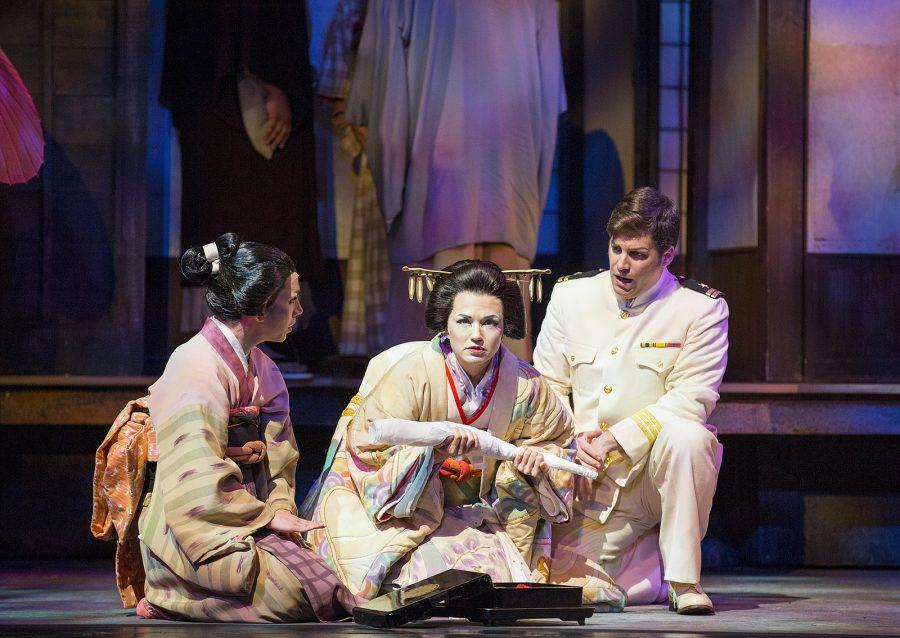“Madama Butterfly” is not timeless. Unlike Mozart’s “Magic Flute” or Shakespeare’s “Merchant of Venice,” the cultural context of Giacomo Puccini’s 1904 opera cannot be ignored.
It was a time when the U.S. was expanding its global influence and sailors regularly married foreign women on their voyages, only to later abandon them and return to the United States.
If anything, “Madama Butterfly” is a story frozen in time, a snapshot of a bygone era when the East and the West were just beginning to cross paths.
It tells the story of a young geisha from Nagasaki, Japan named Cio-Cio-San (Hui He) – which translates to Lady Butterfly — who is married to a happy-go-lucky lieutenant Benjamin Franklin Pinkerton (Piero Pretti). Soon after the marriage, Pinkerton disappears from her life, leaving her and their child to wait another three years before he returns with news that has devastating consequences.
This new revival presented at the Met Opera capitalizes on the interaction between the East and the West, elevating its presence in the work by merging western and eastern theatre techniques.
Set designer Michael Levine’s contemporary set is a marvel of its own. The stage itself is mostly bare, with a black-floored upward slope representing the hill that characters must climb to reach Butterfly’s house.
The revival’s biggest gamble is the use of a huge slanted mirror spanning the entire ceiling, allowing the audience a bird’s-eye view of a portion of the stage. The use of an overhead mirror in theatre can be risky — it could have very easily distracted the audience by making them focus on it rather than what is on stage. Yet Minghella’s adaptation maximizes it perfectly, using it to highlight the grand beauty of the venue and its 120-foot ceiling.
The production’s clever use of the mirror ensured that scenes such as the wedding ceremony in Act 1 were still imbued with breathtaking grandeur. By having the mirror reflect the actors sashaying underneath in vibrantly-colored kimonos, the space they enfold expands rapidly, causing the entire stage to burst with energy and color when scenes call for it.
The stagehands are also a crucial part of the opera. Taking their cue from the traditional Japanese Kabuki theatre, they don all-black outfits with black veils over their faces. They move set pieces and props in seamless motions that never distract from the main characters’ performances. The use of such simple props to influence the setting was a highlight of the show.
In the pinnacle love duet in Act 1, the stagehands carry white paper lanterns on the ends of bamboo poles as they swirl gracefully around Pinkerton and Butterfly. This, reflected onto the mirror above, creates an illusion that the couple is dancing among the stars. Halfway through, the stagehands pause and prop the bamboo sticks upright, and just like that, the stage instantly transforms into a romantic bamboo garden in which two lovers are about to engage in their moonlit tryst.
The stagehands also operate puppets, one of which represents Butterfly’s son. The puppetry in this show draws its inspiration from traditional Japanese Bunraku puppetry, where each stagehand operates one limb of the puppet by direct contact. The coordination of the four stagehands and their low-lying, nondescript movements so successfully creates the illusion of a 3-year-old child yearning for his mother, that at some points, the puppet seems to evoke more emotion than the humans on stage. This stripped-back, traditional use of puppetry amazes with its elegance and simplicity.
Despite its specificity, temporally and geographically, “Madama Butterfly” continues to dazzle modern audiences around the world and inspire new works (most famously, “Miss Saigon”). Much of this continued interest is owed to the creative minds of the producers, directors, set designers and choreographers, who constantly look to create innovative methods to present this beautiful eastern-western fusion of the past to new generations of the future.
“Madama Butterfly”’ is playing at the Met Opera until April 11.
Email Megan Chew at [email protected]

























































































































































